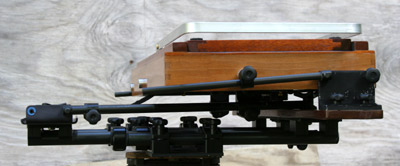
Testing for rail strength
The Rail System
The underlying strength of a camera comes from the platform
on which the working components are placed, the lens, and the sheet of film. The
modern-day field camera design has not changed much in the last 125 years --
wood sliding in wooden groves, with gear racks set into the rail to be driven by
gears on a shaft. This same shaft is also used to prevent the rail from sliding
in and out when locked. This system works well on small cameras, 4x5 thru 8x10.
The rails are short, and the up-and-down play from the necessary
clearance is not noticeable. This
changes as the cameras get bigger.
The play that is inherent in bigger cameras has been a problem for a very long time. To address the problems I and others were having in dealing with this inherent play, I realized I had to think outside the box. I knew two things would not change. They were the front frame that held the lens and the rear ground glass frame and back that held the film holder. I started with a simple look at all the different traditional materials and composites available, along with looking for the best weight-to-strength ratio I could find. The starting point was the weight to strength ratio number I got from figuring out the strength of the average wooden rail on ULF cameras. I started with round aluminum tubes; they worked and they didn�t. After some use and a lot of abuse, the aluminum�s sliding action started to get rough and gritty-sounding, as the rails were slid back and forth (this is an inherent problem with aluminum). After some more testing, I settled on carbon fiber tubes. See photo to the left of the rail system fully extended.
The overall design of the camera was to be modular, with one rail able to handle multiple format sizes. The ULF rail will cover sizes from 7x17 to 20x24. Standard extended length is 34 inches; longer or shorter rails can be custom ordered.
